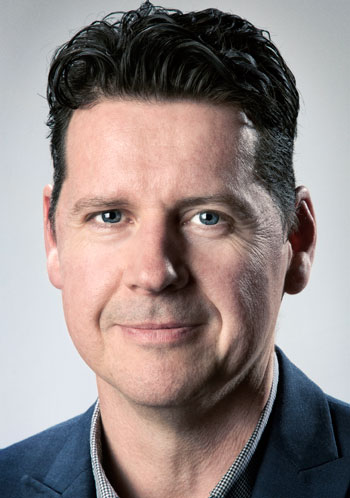
If there’s one brand you’d expect to be aligned with and set up for the digital world, it’s Wired. But don’t mistake it for a technology magazine. Rather, it’s about humanity. And print has an important role to play.
“When people say to me, ‘Oh, Wired’s a tech mag’, I sometimes take umbrage,” admits Greg Williams, editor-in-chief of Wired UK, which was launched in the UK as an offshoot of the original US Wired magazine in 2009 by Condé Nast.
“But Wired isn’t a title about tech, it’s about the way tech shapes human beings and the humans behind it; how the world is, how it’s changing; and where next for people, business, and institutions.”
Hence the bi-monthly title’s promise to readers to “bring you the future today”.
It’s a bold ambition, and commercial performance while working to fulfil it and the long-term digital strategy to support it combined with a commitment to DEI helped Wired UK win ‘Special Interest Magazine / Brand of the Year’ at the 2023 PPA Awards.
And the year in question was certainly a busy one.
For a start, Wired UK covered the war in Ukraine in depth, including how the country has acted like a tech start up, how tech has kept the state functioning, and how tech might aid reconstruction.
It deepened its health coverage – running a major investigation of the gender health gap and how and why it leads to worse outcomes in women across the board, not just women’s health issues, for example.
Multi-platform
Its WIRED Health event exploring the impact and potential of technologies in healthcare, now in its ninth year, went from strength to strength. And it did much around the future of the NHS.
It launched WIRED Impact, a gathering of activists, inventors, authors, and advocates to showcase plans for meeting Net Zero, cutting pollution and building green energy infrastructure.

WIRED Consulting, its business consultancy, enjoyed 60% revenue growth. And this helped power its ‘business services’ (events and consulting combined) to now account for 50% of Wired UK’s total revenues – up from 30% pre-pandemic in 2019.
Meanwhile, it accelerated its other multi-platform activities. It honed its short-form content on its TikTok channel, relaunched in 2021, which by August 2023, had 996,000 followers, for example.
It developed more long-form content on its You Tube channel, where key series ‘Currents’ and ‘Obsessed’ are now major strands. And it evolved its newsletter strategy – its recently launched LinkedIn newsletter already has more than 230,000 subscribers.
And all this at a time when sales for print, which remains profitable, went up, powered by a combination of great journalism, high levels of trust, and its publisher’s ongoing commitment to investing in top quality journalism, photography and design.
In fact, Wired UK’s November / December 2022 issue was it most commercially successful since 2018.
“When I go to the newsagent now, I see all these amazing niche magazines. It’s wonderful to see so many print titles after we were told, ‘Oh, no one will read anything over 300 words’ or ‘Print is dead’, for years and years,” Williams observes.
“There is an appetite for print still and we see that at Wired, too. In fact, I’m quite bullish about it.”
Becoming mainstream
Williams, BSME Editor of the Year (Technology) in 2017, 2018 and 2020, joined Wired UK in 2010 – back when Wired was, he says, pretty much “an outlier”.
“What I mean by that is the areas that we were covering were maybe not top of mind for most people,” Williams recalls.
“But now you pick up – as I do most mornings – the Financial Times and the first five or ten stories on my app could be a Wired story. It’s a reflection of how central tech now is to our modern world.
“Given that everyone in the mainstream news media now has a technology desk and reports on all the kind of stories that we would once think of as our own domain, we’ve almost been drawn to the centre ground.”
And this brings with it a challenge.
“For us, the question is: how do we continue to have a strong voice? And one thing to say about that is that we run a very dynamic newsroom and think very carefully about how we can move stories forward by always asking: okay, what’s next?” he says.
A Wired UK story from June 2021 was about Katalin Karikó, a Hungarian biochemist who started working with mRNA (messenger ribonucleic acid) as early as 1989, for example.
“That story wasn’t just to look at what she’d managed to achieve – and it was an incredible achievement,” he elaborates.
“It was about, so we have this technology, it’s a platform technology, what else can we do with it? What does mRNA mean for medical science and healthcare and how will it impact human beings?”
B2B opportunities
Another important part of maintaining a strong voice is how and where you leverage it. And Williams is proud of Wired’s ability through its journalism to play in both the consumer and business space.
“WIRED Consulting has given us an exciting way to work with some of our commercial partners,” Williams explains.
It’s not just about selling traditional commercial publishing partnerships. Instead, it’s what he calls a “narrative-first approach” – starting with an issue Wired is covering editorially, then identifying how that might then fit with a commercial partner’s area of interest.
“It’s about working with businesses to solve some of their business problems – be that how to transform digitally, or what the new consumer looks like, or how to implement sustainable practices or build biodiversity into their business operations,” he says.
“And that’s all built off the back of our journalistic expertise.”
The aim is to be truly cross-platform. And the strategy is all about making sure everything is joined up.
So, once a story is commissioned, the next step is engaging lots of people to consider how “the journey of that story” should look – audience engagement people to maximise its reach, social people to build engagement, if and how to leverage it on video, and so on.
“How to really make a moment of this – for me, that’s now quite an art. At a time when there’s a real firehose of information, there’s real human skill in getting a Wired story to them in a way that makes it clear they will find it appealing, intriguing and relevant,” Williams says.
Importance of trust
A strong voice in the marketplace also comes from being trusted – something Wired UK takes very seriously. “Without trust, you’re sunk as a brand,” he continues. “So, there’s a number of big things we think very carefully about.”
The first is having truth as its guiding principle – something that during the pandemic in its Covid-19 coverage shone clear. The second is rigour – investing in top journalistic talent that are subject experts, and fact checkers. The third is asking the right questions.
“One thing we do think very hard about when it comes to tech is how it’s built, and what its ends are. I mean, who controls it, who benefits from it, who it exploits, who it endangers,” says Williams.
“It’s my belief that technology isn’t neutral – it contains biases and power structures of the human beings that created it, and you have to be able to recognise that in order to report on it.
“So, we don’t have a black and white approach to reporting tech issues. We try to make sure our coverage remains nuanced because there are lots of shades of grey.”
Wired wouldn’t run ‘AI will destroy the world’, for one thing – an example of the kind of blunt approach to tech taken by some mainstream news organisations that leads to their tech coverage falling short.
“The challenge for many titles is, I think, to not talk about technology as a distinct entity removed from the world,” he adds.
“Because, from waking to your smartphone alarm to getting to sleep with the help of an app, via paying digitally and using productivity tools at work, the fact is today, technology is integrated into pretty much everything all of us do.”
Future opportunities
Looking ahead, Williams highlights a number of growth opportunities – in particular, around consulting and events, further developments around digital storytelling, and video. And challenges, too – like the decline of ‘big social’ driving further media fragmentation.
“Increasingly, people gathering instead away from big social platforms in smaller numbers around interest groups on platforms like Discord and WhatsApp. Keeping track of those people and understanding how best to reach them is already quite tough and will continue to be a challenge,” he explains.
“But when I think about the growing number of brands thinking mindfully about their journalism and investing in it, telling great stories in fresh ways and reaching audiences, I am encouraged. Because it is still possible if you get all of the links in the chain right.”
Another area of interest is artificial intelligence.
And in March, Wired UK was one of the first to publish ground rules for how it would use generative AI, which focus on using it judiciously and transparently – in line with its commitment to supporting its writers, its photographers and its illustrators.
“There’s a real challenge for brands because I think if they do start using AI without making it clear, they will lose trust and then authority because generative AI just isn’t as good as human beings at creating content, whether that’s words or pictures,” says Williams.
“But I do think it could be used internally for suggesting headlines or social posts, or even idea generating, but only in a limited way as a thought starter – much like you’d use Google or Wikipedia, to establish a baseline thought your human skills would then develop.”
For all publishers, he continues, future success will depend on their ability to serve an audience well, establish and retain authority and trust and then evolve it with a cross-platform or multi-platform approach, and build revenue streams that are not necessarily advertising dependent. Which is where the next generation of young writers, designers and illustrators will come in.
“What is and will continue to be really important is for people like me to listen to younger voices and what they think is important to our audience,” he says.
“Often, their perspective is different to that of older members of the team and, often, they’re right. And what it comes down to is trust: trusting your audience, trusting your team, trusting your team’s judgement and the decisions they make.”
This article was first published in InPublishing magazine. If you would like to be added to the free mailing list to receive the magazine, please register here.












